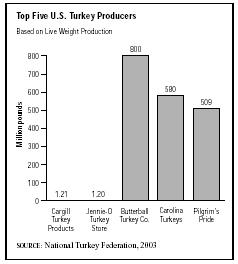SIC 0253
TURKEYS AND TURKEY EGGS
This category includes establishments primarily engaged in the production of turkeys and turkey eggs.
NAICS Code(s)
112330 (Turkey Production)
Turkey production in the United States was on the decline in the late 1990s and early 2000s, after peaking with a record 310 million birds produced in 1996, according to the U.S. Department of Agriculture (USDA). Although

U.S. turkey production climbed 1 percent to 274 million birds in 2003, this number was well below the 301 million birds produced in 1997. In 2004, U.S. turkey growers decided to implement a 4 percent decrease in the number of birds raised.
Through 2002 North Carolina remained the turkey capital, producing 45.5 million birds that year, down from 50 million birds in 1998. In 2003, however, Minnesota, usurped North Carolina as the top turkey producer in the United States with 45 million birds, compared to 44.5 million turkeys produced in North Carolina. Arkansas and Missouri tied for a distant third, producing 26.5 million turkeys each in 2003, while fourth-ranked Virginia produced 23 million. During 2003, these states accounted for 71 percent of all turkeys produced in the United States.
Turkey production in 2002 grew from 7.15 billion pounds live weight to 7.40 billion pounds live weight, due to an increase in the number of birds slaughtered, as well as heavier bird weights. Producers received an average wholesale price of 64.5 cents per pound in 2002, down nearly 3 percent from 2001. Retail prices declined by roughly 4 percent over the same time period.
Turkey exports dropped 10 percent to 439 pounds in 2002. The decline was due in large part to decreased demand in Mexico, the largest export market for U.S. turkey producers, accounting for roughly 45 percent of U.S. turkey exports. Also impacting export numbers was the ban on U.S. turkey imports implemented by Russian officials during a portion of 2002. Turkey exports grew by nearly 20 percent in 2003, however, due to a recovery in the Mexican economy. Analysts expected additional growth in exports in 2004.
In the late 1990s and early 2000s, the turkey industry grappled with many problems, including flattened consumption, weak selling prices, increasing problems with turkey disease, high feed costs, excess inventories, and low selling prices. Technology also hurt the industry. Genetic engineering has produced turkeys with larger breasts, leading to excess inventories. Also, a growing number of processors are using less meat and supplementing with fillers—like basting solutions—in place of meat. This has led to a glut of turkey. To offset this trend, turkey growers throughout the U.S. planned to decrease production in 2004. Minnesota planned to reduce the number of turkeys raised by 4 percent; North Carolina, by 11 percent; Arkansas, by 2 percent, Missouri, by 4 percent; Virginia, by 4 percent; and California, by 7 percent.
While the number of turkeys produced has declined, so has the number of establishments engaged in the industry, as well as income for those establishments. Between 2000 and 2002 turkey farm income declined from $2.82 billion to $2.70 billion. According to the National Turkey Federation, the industry is led by Cargill Turkey Products, which produced about 1.21 billion pounds live weight in 2003. A close second, the Jennie-O Turkey Store produced 1.20 billion pounds live weight that year. Butterball Turkey Co. is the third-leading producer, with 800 million pounds, followed by Carolina Turkeys at 580 million pounds and Pilgrim's Pride at 509 million pounds.
Further Reading
National Turkey Federation. Statistics. Washington, DC: 2003. Available from http://www.eatturkey.com/press/stats/stats.html .
U.S. Department of Agriculture. Livestock, Dairy, and Poultry Outlook. Washington, DC: 27 January 2004. Available from http://usda.mannlib.cornell.edu/reports/erssor/livestock/ldp-mbb/2004/ldpm116t.pdf .
U.S. Department of Agriculture Economic Research Service. Poultry and Eggs: Trade. Washington, DC: 14 November 2004. Available from http://www.ers.usda.gov/Briefing/Poultry/trade.htm .
——. "Turkeys." Washington, DC: January 2004. Available from http://usda.mannlib.cornell.edu/reports/nassr/poultry/pth-bbt/tuky0104.txt .
Comment about this article, ask questions, or add new information about this topic: